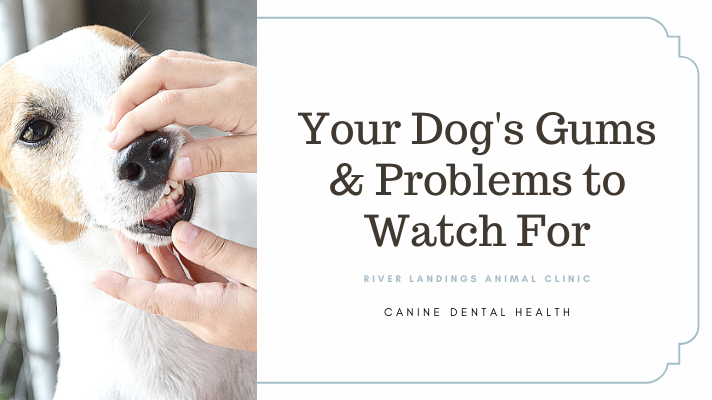Gums can be an often-overlooked part of a dog’s mouth, but they’re just as important to keep clean and healthy as your dog’s teeth! Below, learn more about what color your dog’s gums should be, gum problems to look out for, and how to help your dog maintain healthy gums.
What Color Should My Dog’s Gums Be?
If you want to know what healthy dog gums look like, look no further than the seafood bar at your local grocery store. Healthy gums should appear shrimp-colored pink and unhealthy gums will appear red and inflamed.
Certain diseases can cause discoloration of the gums. For instance, red, inflamed gums can be a sign of gingivitis. Gingivitis is caused by plaque, which is composed mostly of bacteria. Plaque can accumulate on the tooth surface especially in the space underneath the gum line. Gingivitis is also caused by the body's oral immune system reacting to the plaque bacteria on the teeth.
If your dog’s gums are other colors, that can also be indicative of additional health problems. If the gums are pale or white, that could be a sign of anemia. If the gums are blue that often means that your dog is not getting oxygen. If the gums are yellow in a dog, it can be a sign of Leptospirosis, a bacterial infection that can cause liver disease, and jaundice, which can also be a sign of liver disease.
Common Gum Problems in Dogs
Another sign of unhealthy gums? Bad breath. Bad breath or especially a sudden worsening of the breath is often associated with worsening of gum disease.
Gum disease is usually caused not by problems with the gums, but by bacteria on the teeth. So to take care of the gums, brush your dog's teeth. The best and most common way to prevent gum disease is to brush their teeth every day using a soft-bristle toothbrush. Brushing aside, you also can use products approved by your vet, such as dental-maintenance chews (we sell OrvoVet Dental Chews—just ask our receptionists!).
Periodontal disease is the most common cause of unhealthy gums, but other diseases such as immune-mediated inflammatory disease, bleeding disorders, gingival enlargements, and even oral cancers can also cause unhealthy gums. Periodontal disease is most common in dogs under 30 pounds. This is due to crowding—small dogs tend to have large teeth in a relatively small mouth.
Read more: Periodontal Disease and Treatment: Dental Scaling
Additionally, breeds like boxers can be prone to gum overgrowth, a benign condition that is genetic in nature. Although the condition itself is benign, it can result in an almost tumor-like overgrowths of gum tissue which can cause pseudopockets in the dog’s gums.
If you can imagine gum tissue growing up and around the tooth, you can imagine it forming this little nook, cranny or pocket between the overgrown gum and the tooth where fur and debris and food can get stuck and subsequently cause bad breath and infection.
Additional Gum Issues to Watch Out For
Younger dogs, and puppies especially, can come down with papillomatosis, or warts of the gums. Signs include the appearance of solitary, clusters, or even hundreds of warts. If you see one or two warts, don’t worry. Those will usually fall off in one to two months. Dogs with an abundance of warts, however, may need to have surgery to remove them.
Over time, the texture of an older dog’s gums can become more cobbled looking. A cobbled texture in and of itself is nothing to fret about, but cobbled gums can be a sign of cancer. Depending on the type of cancer, if the cobbled gums are accompanied by bad breath, oral pain, reluctance or difficulty chewing, and oral bleeding, seek out a vet to examine your pet.
However, rather than fret over textural changes, it's the color of the gums or if they are bleeding or look like they are going to bleed easily to be more concerned about.
Additionally, rough or intense chewing on a toy or a bone can cause gums to bleed. Sharp pieces of the chew toy could temporarily roughen up the gum. If this is the case, this gum condition normally is not a serious issue, unless the bleeding doesn’t stop. If bleeding lasts more than 10 minutes, it is advised to seek emergency treatment.
Bleeding gums could be a sign of oral cancer, kidney failure (high levels of ammonia can accumulate causing ulcerations and gum bleeding), or idiopathic thrombocytopenic purpura (or ITP)—when the immune system destroys platelets so blood doesn’t clot. If a dog consumes rat poison, it also could cause their gums to bleed,
How Can Gum Problems Be Treated?
If you suspect your dog has gum problems, head to the vet. Your veterinarian will perform a complete dental exam under general anesthesia and take dental X-rays to determine the appropriate treatment.
Treatment is based on the results of the exam and X-rays, and may include anything from a good cleaning of the plaque and tartar on the tooth surface to periodontal surgery or even tooth extraction. If other diseases are suspected (like an immune disease or cancer), a gum biopsy can be obtained and observed.
If you suspect your dog already has a dental disease, it’s best to have a vet treat the condition first and then start an at-home gum-care program.
If your pet has a preexisting dental problem that could be associated with oral sensitivity, it may be beyond the point where tooth brushing is going to do any help. It’s just going to irritate the dog. When your pet has a mouthful of healthy teeth left, then is the time to start on a home-care program with tooth brushing!
Hear From Us Again
Don't forget to subscribe to our email newsletter for more recipes, articles, and clinic updates delivered straight to your e-mail inbox.

